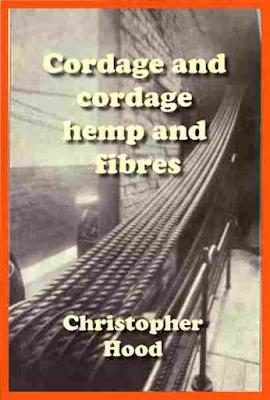Cordage and cordage hemp and fibres
The function of a small article in commercial under- takings is often overshadowed by that of the larger and usually more valuable article, and yet the use of the former is often an absolute necessity for the safety of the latter.
This relative value is emphasized in the use of cordage because the successful prosecution of many industries depends in no mean way upon the utilization of this useful and common commodity. Some of the various types of cordage are well known to the general public, but the methods employed in their manufacture, the machinery used, and the sources of the fibres are not quite so well known. We trust that these phases are discussed in as brief but as complete a way as is possible in this little book, which we hope will take its own place in the literature of our Common Commodities of Commerce.
The separation of fibrous material from various kinds of plants is by no means of modern origin, for the great antiquity of yarns which have been spun from vegetable and animal fibres is universally acknowledged. Reference to the process of preparing flax for the purpose spinning appears in Exodus ix, verse 31, while the first Biblical reference to thread one of the technical names for a continuous length of prepared fibrous material is in Genesis xiv, verse 23: " That I will not take from a thread even to a shoe-latchet." Again, another early reference in Chapter xxxviii refers to a scarlet thread, an indication or suggestion that the art of dying was also known at this early period in the early Biblical history.
Herodotus records garments made from hemp by the Thracians, and to the present day, hemp is largely cultivated in the vicinity of the lands occupied by the descendants of this ancient race. Moschion, whose writings appeared before the Chris- tian era, states that the " great ships of Syracuse which were built by command of Hiero II were supplied with hemp and ropes from the Rhone districts.
Hemp was brought from Colchis to the ports of the Aegean Sea by the merchants who were connected commercially with the north and east coasts of the Euxine through their Milesian colonies."
Pliny also records the use of hemp for ships and states that it was in common use among the Romans in the first century for ropes and sails, as well as for other purposes.
The more or less uncertain knowledge of practically all the earlier attempts at the solution of fibre extraction renders it impossible for us to bridge the gap between the time when crude primitive methods were practised and that which ushered in the more perfect methods described by Pliny in the first century methods which, in certain cases, have varied little since this early period, and which are practised with a high degree of success.
We may, therefore, leave this interesting period to the researches of students in history, and enter upon the description and illustration of the various plants from which fibre is extracted, and the actual processes which such fibre has to undergo before it is ready for the market in one or other of the well-known types of cordage.
Contents:
PREFACE . . . , . V
I. INTRODUCTORY ..... 1
II. DEFINITION OF CORDAGE AND SOURCES OF FIBRES 5
III. CLASSIFICATION OF FIBRES . . . .16
IV. THE CULTIVATION OF HEMP . . .19
V. RETTING, BREAKING AND SCUTCHING . . 24
V. RETTING, BREAKING AND SCUTCHING . . 24
VI. THE CULTIVATION OF PLANTS FOR HARD FIBRES ...... 31
VII. THE PREPARING AND SPINNING MACHINERY
FOR HEMP AND OTHER SOFT FIBRES. 55
VIII. THE PREPARING AND SPINNING MACHINERY
FOR MANILA AND OTHER HARD FIBRES. 87
IX. TWINES, CORDS AND LINES . . .93
x. ROPES AND ROPE-MAKING; YARN NUMBERING 100
XI. MARKETING .... 108
Download 14 MB


